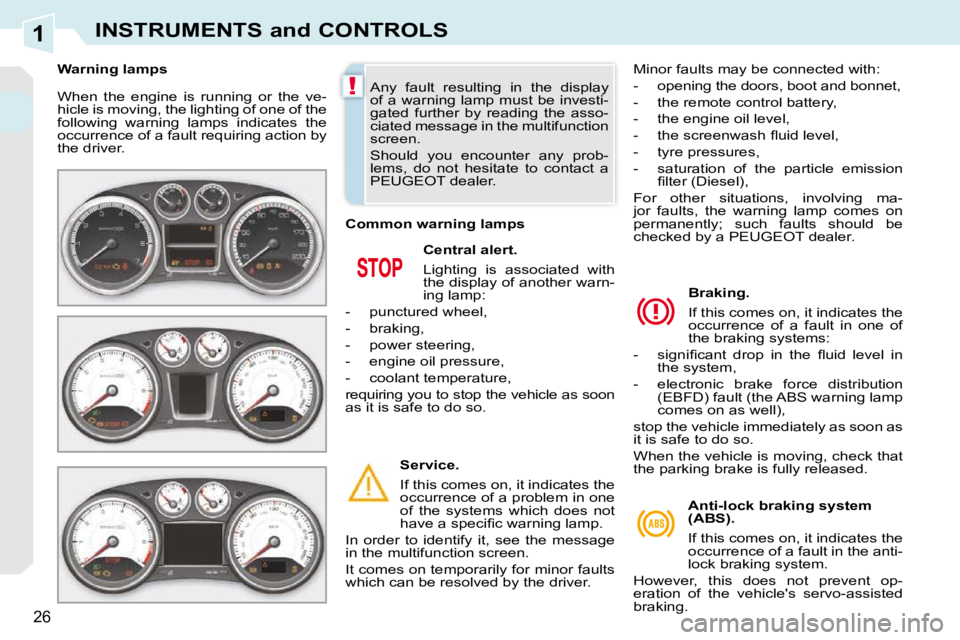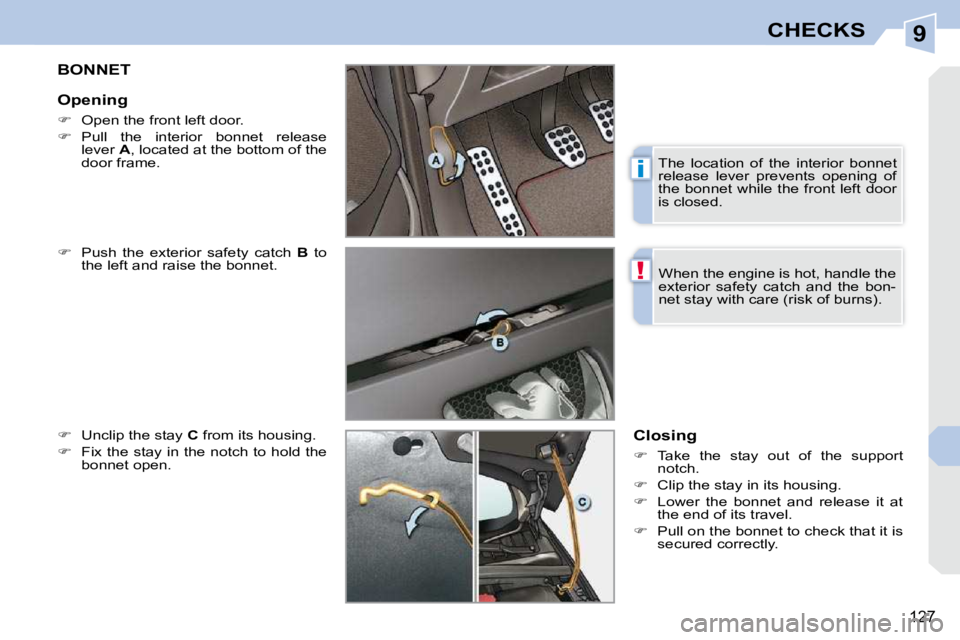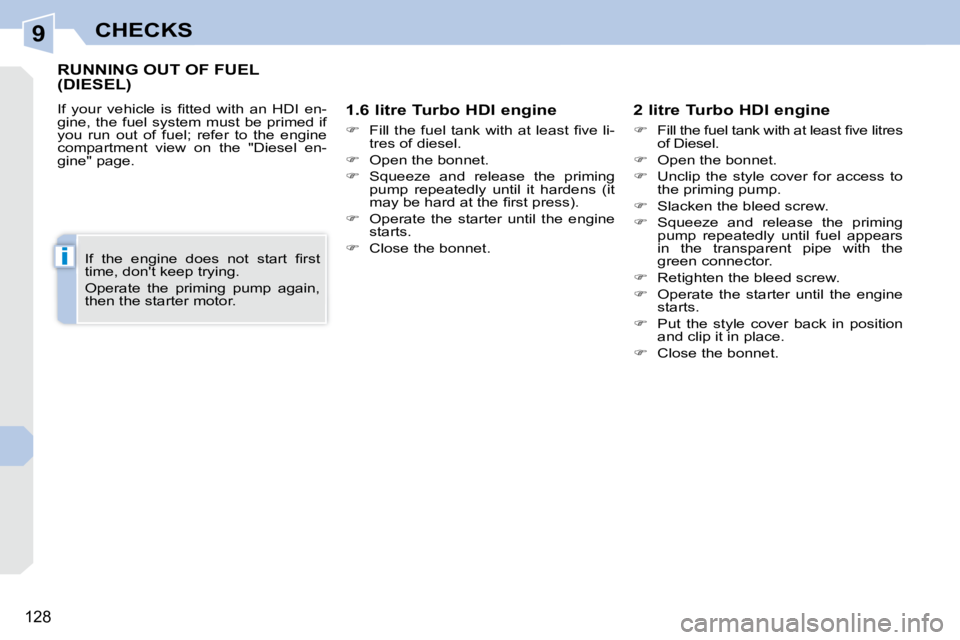2010 PEUGEOT 308 CC DAG bonnet
[x] Cancel search: bonnetPage 6 of 280

FAMILIARISATION
1. Cruise control/speed limiter switches.
2. Steering wheel adjustment control.
3. Lighting and direction indicator
control stalk.
4. Instrument panel.
5. Driver's airbag.
Horn.
6. Gear lever.
7. Parking brake.
8. 12 V accessory socket.
9. Heated seat control.
10. Door mirror controls.
Electric window controls.
11. Bonnet release.
12. Fusebox.
13. Manual headlamp height
adjustment.
14. Side adjustable air vent.
15. Front side window demisting vent.
16. � � �S�p�e�a�k�e�r� �(�t�w�e�e�t�e�r�)�.�
17. Windscreen demisting vent.
INSTRUMENTS AND CONTROLS
Page 23 of 280

1
!
26
INSTRUMENTS and CONTROLS
When the engine is running or the ve-
hicle is moving, the lighting of one of the
following warning lamps indicates the
occurrence of a fault requiring action by
the driver. Central alert.
Lighting is associated with
the display of another warn-
ing lamp:
- punctured wheel,
- braking,
- power steering,
- engine oil pressure,
- coolant temperature,
requiring you to stop the vehicle as soon
as it is safe to do so.
Service.
If this comes on, it indicates the
occurrence of a problem in one
of the systems which does not
�h�a�v�e� �a� �s�p�e�c�i�fi� �c� �w�a�r�n�i�n�g� �l�a�m�p�.�
In order to identify it, see the message
in the multifunction screen.
It comes on temporarily for minor faults
which can be resolved by the driver. Braking.
If this comes on, it indicates the
occurrence of a fault in one of
the braking systems:
� � � �-� � �s�i�g�n�i�fi� �c�a�n�t� �d�r�o�p� �i�n� �t�h�e� �fl� �u�i�d� �l�e�v�e�l� �i�n� the system,
- electronic brake force distribution (EBFD) fault (the ABS warning lamp
comes on as well),
stop the vehicle immediately as soon as
it is safe to do so.
When the vehicle is moving, check that
the parking brake is fully released.
Any fault resulting in the display
of a warning lamp must be investi-
gated further by reading the asso-
ciated message in the multifunction
screen.
Should you encounter any prob-
lems, do not hesitate to contact a
PEUGEOT dealer.
Warning lamps
Anti-lock braking system
(ABS).
If this comes on, it indicates the
occurrence of a fault in the anti-
lock braking system.
However, this does not prevent op-
eration of the vehicle's servo-assisted
braking.
Common warning lamps
Minor faults may be connected with:
- opening the doors, boot and bonnet,
- the remote control battery,
- the engine oil level,
� � �-� � �t�h�e� �s�c�r�e�e�n�w�a�s�h� �fl� �u�i�d� �l�e�v�e�l�,�
- tyre pressures,
- saturation of the particle emission
�fi� �l�t�e�r� �(�D�i�e�s�e�l�)�,� �
For other situations, involving ma-
jor faults, the warning lamp comes on
permanently; such faults should be
checked by a PEUGEOT dealer.
Page 74 of 280

4
!
i
70
ACCESS
ALARM
System which protects and provides a
deterrent against theft and break-ins.
It provides the following types of moni-
toring. Locking the vehicle with full
alarm system
For all work on the alarm system,
contact a PEUGEOT dealer. Activation
� Switch off the ignition and get out of
the vehicle.
� Press the locking button on the re-
mote control.
The monitoring system is active: the in-
�d�i�c�a�t�o�r� �l�a�m�p� �i�n� �t�h�e� �b�u�t�t�o�n� �fl� �a�s�h�e�s� �o�n�c�e�
per second.
After the locking button on the remote
control is pressed, the exterior perime-
ter monitoring is activated after a delay
of 5 seconds and the interior volumetric
monitoring after a delay of 45 seconds.
- Exterior perimeter
The system checks for opening of the
vehicle.
The alarm is triggered if anyone tries to
open a door, the boot, the bonnet...
- Interior volumetric
The system checks for any variation in the
volume in the passenger compartment.
The alarm is triggered if anyone breaks
a window, enters the passenger com-
partment or moves inside the vehicle.
Self-protection function
The system checks for the putting out of
service of its components.
The alarm is triggered if the battery, the
central control or the wires of the siren
are put out of service or damaged.
Deactivation
� Press the unlocking button on the
remote control.
The alarm system is deactivated: the indi-
cator lamp in the button goes off.
If an opening (door, boot...) is not
closed fully, the vehicle is not locked
but the exterior perimeter monitor-
ing will be activated after a delay
of 45 seconds at the same time as
the interior volumetric monitoring.
Page 141 of 280

9
i
!
127
CHECKS
BONNET
� Push the exterior safety catch B to
the left and raise the bonnet.
� Unclip the stay C from its housing.
� Fix the stay in the notch to hold the
bonnet open. Closing
� Take the stay out of the support
notch.
� Clip the stay in its housing.
� Lower the bonnet and release it at
the end of its travel.
� Pull on the bonnet to check that it is
secured correctly.
Opening
� Open the front left door.
� Pull the interior bonnet release
lever A , located at the bottom of the
door frame. The location of the interior bonnet
release lever prevents opening of
the bonnet while the front left door
is closed.
When the engine is hot, handle the
exterior safety catch and the bon-
net stay with care (risk of burns).
Page 142 of 280

9
i
128
CHECKS
RUNNING OUT OF FUEL (DIESEL)
� �I�f� �y�o�u�r� �v�e�h�i�c�l�e� �i�s� �fi� �t�t�e�d� �w�i�t�h� �a�n� �H�D�I� �e�n�-
gine, the fuel system must be primed if
you run out of fuel; refer to the engine
compartment view on the "Diesel en-
gine" page. 1.6 litre Turbo HDI engine
� � � �F�i�l�l� �t�h�e� �f�u�e�l� �t�a�n�k� �w�i�t�h� �a�t� �l�e�a�s�t� �fi� �v�e� �l�i�-
tres of diesel.
� Open the bonnet.
� Squeeze and release the priming
pump repeatedly until it hardens (it
�m�a�y� �b�e� �h�a�r�d� �a�t� �t�h�e� �fi� �r�s�t� �p�r�e�s�s�)�.�
� Operate the starter until the engine
starts.
� Close the bonnet. 2 litre Turbo HDI engine
� � � �F�i�l�l� �t�h�e� �f�u�e�l� �t�a�n�k� �w�i�t�h� �a�t� �l�e�a�s�t� �fi� �v�e� �l�i�t�r�e�s�
of Diesel.
� Open the bonnet.
� Unclip the style cover for access to
the priming pump.
� Slacken the bleed screw.
� Squeeze and release the priming
pump repeatedly until fuel appears
in the transparent pipe with the
green connector.
� Retighten the bleed screw.
� Operate the starter until the engine
starts.
� Put the style cover back in position
and clip it in place.
� Close the bonnet.
� �I�f� �t�h�e� �e�n�g�i�n�e� �d�o�e�s� �n�o�t� �s�t�a�r�t� �fi� �r�s�t�
time, don't keep trying.
Operate the priming pump again,
then the starter motor.
Page 145 of 280

9
!
131
CHECKS
CHECKING LEVELS
Check all of these levels regularly and
top them up if necessary, unless other-
wise indicated.
� �I�f� �a� �l�e�v�e�l� �d�r�o�p�s� �s�i�g�n�i�fi� �c�a�n�t�l�y�,� �h�a�v�e� �t�h�e�
corresponding system checked by a
PEUGEOT dealer. Brake fluid level
In addition, as the cooling system is
pressurised, wait at least one hour after
switching off the engine before carrying
out any work.
To avoid any risk of scalding, unscrew
the cap by two turns to allow the pres-
sure to drop. When the pressure has
dropped, remove the cap and top up
the level.
Oil level The reading will only be correct
if the vehicle is on level ground
and the engine has been off for
more than 15 minutes.
The check is carried out either when the
ignition is switched on using the oil level
indicator on the instrument panel, or us-
ing the dipstick. � �T�h�e� �b�r�a�k�e� �fl� �u�i�d� �l�e�v�e�l� �s�h�o�u�l�d� �b�e�
close to the "MAX" mark. If it is
not, check the brake pad wear.
� � �C�h�a�n�g�i�n�g� �t�h�e� �fl� �u�i�d�
Refer to the Warranty and Maintenance
Record for details of the interval for this
operation.
Power steering fluid level � �T�h�e� �p�o�w�e�r� �s�t�e�e�r�i�n�g� �fl� �u�i�d� �l�e�v�e�l�
should be close to the "MAX"
mark. Unscrew the cap, with the
engine cold, to check the level. Screenwash and headlamp
wash fluid
� �I�n� �t�h�e� �c�a�s�e� �o�f� �v�e�h�i�c�l�e�s� �fi� �t�t�e�d�
with headlamp washers, the
�m�i�n�i�m�u�m� �l�e�v�e�l� �o�f� �t�h�i�s� �fl� �u�i�d� �i�s�
indicated by an audible signal
and a message on the multifunction
screen.
Top up the level when you stop the vehicle.
Engine oil change
Refer to the Warranty and Maintenance
Record for details of the interval for this
operation.
In order to maintain the reliability of the
engine and emission control system,
the use of additives in the engine oil is
prohibited.
� � �O�i�l� �s�p�e�c�i�fi� �c�a�t�i�o�n�
The oil must correspond to your en-
gine and conform to the manufacturer's
recommendations. � � �F�l�u�i�d� �s�p�e�c�i�fi� �c�a�t�i�o�n�
� �T�h�e� �b�r�a�k�e� �fl� �u�i�d� �m�u�s�t� �c�o�n�f�o�r�m� �t�o� �t�h�e�
manufacturer's recommendations and
�f�u�l�fi� �l� �t�h�e� �D�O�T�4� �s�t�a�n�d�a�r�d�s�.� � �
Changing the coolant
The coolant does not have to be
changed.
� � �F�l�u�i�d� �s�p�e�c�i�fi� �c�a�t�i�o�n�
For optimum cleaning and to avoid
�f�r�e�e�z�i�n�g�,� �t�h�i�s� �fl� �u�i�d� �m�u�s�t� �n�o�t� �b�e� �t�o�p�p�e�d�
up with or replaced with plain water.
Coolant level
The coolant level should be
close to the "MAX" mark but
should never exceed it.
When the engine is warm, the tempera-
ture of the coolant is regulated by the fan.
This can operate with the ignition off.
�O�n� �v�e�h�i�c�l�e�s� �w�h�i�c�h� �a�r�e� �fi� �t�t�e�d� �w�i�t�h� �a�
�p�a�r�t�i�c�l�e� �e�m�i�s�s�i�o�n� �fi� �l�t�e�r�,� �t�h�e� �f�a�n� �m�a�y�
operate after the vehicle has been
�s�w�i�t�c�h�e�d� �o�f�f�,� �e�v�e�n� �i�f� �t�h�e� �e�n�g�i�n�e� �i�s�
cold. � � �F�l�u�i�d� �s�p�e�c�i�fi� �c�a�t�i�o�n�
The coolant must conform to the manu-
facturer's recommendations.
When working under the bonnet,
take care, as certain areas of the
engine may be extremely hot (risk
of burns).
Page 186 of 280

11
!
i
168
TECHNICAL DATA
IDENTIFICATION MARKINGS
� �V�a�r�i�o�u�s� �v�i�s�i�b�l�e� �m�a�r�k�i�n�g�s� �f�o�r� �t�h�e� �i�d�e�n�t�i�fi� �-
cation and tracking of your vehicle. � �W�h�e�e�l�s� �w�h�i�c�h� �a�r�e� �fi� �t�t�e�d� �w�i�t�h� �2�2�5�/�4�0�
�R�1�8� �t�y�r�e�s� �c�a�n�n�o�t� �b�e� �fi� �t�t�e�d� �w�i�t�h�
snow chains. For further informa-
tion, contact a PEUGEOT dealer.
� �I�f� �t�h�e� �i�n�fl� �a�t�i�o�n� �p�r�e�s�s�u�r�e�s� �a�r�e� �t�o�o� �l�o�w�,�
this increases fuel consumption.
� �T�h�e� �i�n�fl� �a�t�i�o�n� �p�r�e�s�s�u�r�e�s� �m�u�s�t� �b�e�
checked when the tyres are cold,
at least once a month.
A. �V�e�h�i�c�l�e� �i�d�e�n�t�i�fi� �c�a�t�i�o�n� �n�u�m�b�e�r� �(�V�I�N�)�
under the bonnet.
This number is engraved on the bodywork near the damper support.
For access to it, raise the plastic cover.
B. VIN on the windscreen lower cross-
member.
This number is indicated on a self- adhesive label which is visible
through the windscreen.
C. Manufacturer's label.
This number is indicated on a self- �d�e�s�t�r�o�y�i�n�g� �l�a�b�e�l� �a�f�fi� �x�e�d� �t�o� �t�h�e� �d�o�o�r�
aperture, below the door striker, on
the right-hand side.
D. Tyre/paint label.
� �T�h�i�s� �l�a�b�e�l� �i�s� �a�f�fi� �x�e�d� �t�o� �t�h�e� �d�o�o�r� �a�p�e�r�- ture, on the driver's side.
It bears the following information:
� � � �-� � �t�h�e� �t�y�r�e� �i�n�fl� �a�t�i�o�n� �p�r�e�s�s�u�r�e�s�,� �l�a�d�e�n� and unladen,
- the wheel rim and tyre sizes,
- the brands of tyre recommended by the manufacturer,
� � �-� � �t�h�e� �i�n�fl� �a�t�i�o�n� �p�r�e�s�s�u�r�e� �o�f� �t�h�e� �s�p�a�r�e� wheel,
- the paint colour code.